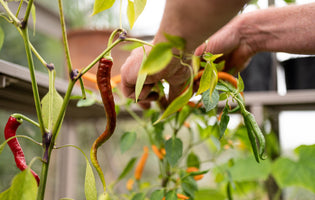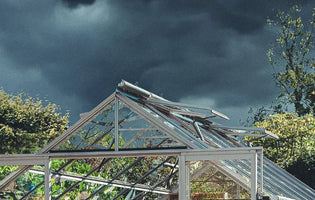Having a greenhouse opens the opportunity of not only extending the growing season but also means you can cultivate all sorts of plants, fruit and vegetables all year round. Because you can control the environment in the greenhouse to give the plants their optimal growing conditions, you can have a go at cultivating a variety of crops that are tolerant to the cold or prefer more warm and humid climates.

In this blog, we will focus on crops that are ideal for winter greenhouse gardening and some essential tips to help your winter greenhouse be successful.
Crops for a winter greenhouse
There is a huge variety of crops ideal for winter greenhouse gardening; in fact, some will positively thrive and give you homegrown vegetables throughout the cold season. Here are our top recommendations.
- Leafy greens
Full of iron and natural, healthy goodness, leafy greens are perfect for your winter greenhouse. Many varieties are good at tolerating winter’s cooler temperatures, such as kale, spinach and Swiss chard. You can also grow salad leafy greens, like lettuce, rocket and chard. Don’t forget the leafy herbs, which include basil, coriander, mint and dill.
Many of these leafy plants can be grown and harvested throughout the winter season in a greenhouse and are nutrient-rich, too.
- Root vegetables
You don’t need an outdoor bed to grow root vegetables in the winter. Many varieties are, in fact, ideal for growing in a greenhouse, too. Root vegetables, like carrots, turnips, parsnips and beetroot, as well as radishes and onions, are more than suitable. Ideally, you’ll have an area of well-drained soil so the plants can develop healthy roots, but if you don’t have a dedicated bed in the greenhouse, don’t be put off. You can grow them in containers instead, as long as they are deep and you can space out the plants in the soil to allow them room to develop and grow.
- Herbs
Many different herbs will thrive in a greenhouse over the winter, such as parsley, thyme, coriander, sage, marjoram, tarragon, cilantro, rosemary and an old favorite, mint. Many herbs are aromatic, and you’ll smell them as you walk into your greenhouse, but they also add delicious flavors to your culinary dishes. Some herbs are better grown in pots or tubs as they can grow vociferously and may take over, such as mint and parsley. It also makes it easier to transfer them outside in the summer months. But it’s great to be able to harvest herbs as and when you need them.
- Microgreens
Microgreens are all the rage, and that’s because these tiny seedlings are packed full of natural nutrients. Harvested when they are young, they are perfect for winter greenhouse gardening as they don’t take up a lot of space and grow quickly. Examples of popular microgreens are beetroots, peas, broccoli, cress, spinach, chives, fennel, lettuce, cabbage, arugula, lettuce and mesclun (a mix of assorted salad greens). Having microgreens ‘on tap’ gives you a fresh way to add fabulous flavors to so many of your winter dishes.
- Cold-tolerant flowers
There’s nothing better than adding a flash of color in winter, and one of the best ways of doing this is by growing flowering plants that don’t mind the cold in your winter greenhouse. There is a wide choice to choose from, some of which are easier to grow than others, including violas, snapdragons, calendula, impatiens, lilies, dahlias, pansies and even some varieties of orchids. One thing is for sure; they will add color, beauty and vibrancy to your greenhouse and home during the dark winter months.
4 tips for successful winter greenhouse gardening
Winter greenhouse gardening means you can have crops, salad produce, herbs and flowers all year round right outside your back door. Here are our top tips to help your winter gardening be a success.
- Temperature control
Keep an eye on the temperature inside your greenhouse and monitor it to ensure it stays within the optimal range for the plants you’re growing. Although it’s winter, the sun can still heat a greenhouse quite significantly, but a frost will drop the temperature considerably.
Regulate the temperature as you need to by opening windows or doors for the right level of ventilation during the day and closing at night. You might also want to consider using a greenhouse heater or system and adding insulation, blinds or shades, and even greenhouse fans to keep the air circulating to maintain a consistent, comfortable environment.
- Light and humidity
Remember that daylight hours in the winter are much shorter, so you will need to supplement any natural sunlight with artificial lighting so the plants have sufficient illumination. Some plants require a higher humidity too, so make sure this is monitored and adjusted accordingly to stop plants drying out, particularly if you are heating your greenhouse.
- Watering and drainage
One thing to be aware of is overwatering. Many plants don’t need as much water during the winter months, so it's easy to give them too much. Make sure all the pots and containers have drainage holes in the bottom; you may want to add a thin layer of small stones/pebbles before you add the soil or compost to aid drainage. When plants are waterlogged, it can cause bacteria, fungus and root rot.
- Pest and disease management
Harmful pests aren’t just for the summer months; you will also experience them during winter, despite the colder temperatures. Check your plants daily for any signs of disease, damage or infestation. If you find anything, deal with the pests using organic pest control products, make your natural pesticide, or opt for preventative treatments, like sticky fly strips, keeping windows, surfaces and floors clean, and ensuring there’s plenty of ventilation.







